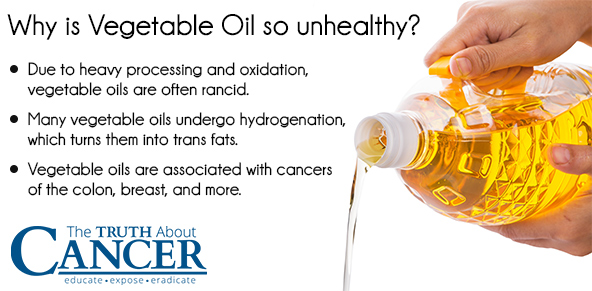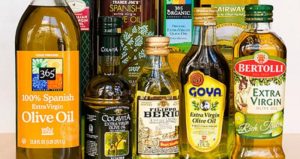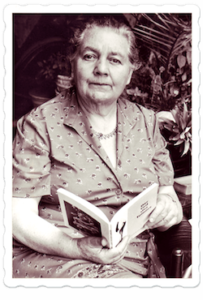 Have you wondered why nutritionists say “Be careful about using oxidative vegetable oils on the grocery shelf? It is because all oils on the grocery shelf except extra virgin olive oil have been boiled to over 300 degrees Fahrenheit EXCEPT COCONUT OIL, PALM OIL, BUTTER, RAW LARD, AND SUET. These omega-6 Cooked oils on the grocery shelf not only have no electromagnetic value, but they are prone to oxidation, which means they are oxidative instead of being an anti-oxidant and have no electromagnetic health value. Some nutritionists call them “dead” oils. They may cause serious health problems if used in deep-fried meat, beans, and other vegetables, plus even worse if combined with sugar products in the diet.
Have you wondered why nutritionists say “Be careful about using oxidative vegetable oils on the grocery shelf? It is because all oils on the grocery shelf except extra virgin olive oil have been boiled to over 300 degrees Fahrenheit EXCEPT COCONUT OIL, PALM OIL, BUTTER, RAW LARD, AND SUET. These omega-6 Cooked oils on the grocery shelf not only have no electromagnetic value, but they are prone to oxidation, which means they are oxidative instead of being an anti-oxidant and have no electromagnetic health value. Some nutritionists call them “dead” oils. They may cause serious health problems if used in deep-fried meat, beans, and other vegetables, plus even worse if combined with sugar products in the diet.
Being “oxidative” means that the atoms in these molecules of oil have lost an electron, making them an oxidant. Oxidants are unstable atoms and molecules and become unstable and sometimes mutated in body cells causing considerable risk of many diseases including cancer.
Another health hazard of vegetable oils on the grocery shelf is that the oils have been refined using many industrial chemicals and processes. They are processed using the chemical Hexane. Hexane is a crude oil solvent that is usually the choice oil makers use to extract the solvent from the oil.
 Not enough research has been done to find the serious harm that oxidative vegetable oiils on the grocery shelf do. But researchers found the exact cause of the oxidation and inflammation problem which is the formation of “megatrans,” and “transfats” from vegetable oils. They are the culprits. Oxidative vegetable oils on the grocery shelf are the worst fats to consume, and in excess, are known to cause diseases and cancer.
Not enough research has been done to find the serious harm that oxidative vegetable oiils on the grocery shelf do. But researchers found the exact cause of the oxidation and inflammation problem which is the formation of “megatrans,” and “transfats” from vegetable oils. They are the culprits. Oxidative vegetable oils on the grocery shelf are the worst fats to consume, and in excess, are known to cause diseases and cancer.
Starting in the 1980s, researchers were finding that people on a high vegetable oil diet died at a higher rate of heart disease and cancer than people who ate less vegetable oils. The connection between vegetable oil oxidation and relation to disease was outlined in a book by Nina Teicholz who wrote about the problems with oxidative vegetable oils in a book called, “The Big Fat Surprise.”
Many years ago, before refrigeration, many grocery store owners found that the vegetable oils on the grocery shelf were turning rancid. They found a nice trick in boiling the oils so the oils would maintain their nice color, taste, and constancy. Thus helping their bottom line. The cooking of vegetable oils was great for the retailers because they could put them on the grocery shelf and the oils would not change or become rancid.
Dr. Ancil Keys, in the 1950s, hypothesized that replacing animal fat with vegetable oils would increase polyunsaturated fat, lower blood cholesterol, and reduce heart disease. But Dr. Keys did not have all of the information available to prove his theory. It is now known that the old lard, suet, uncooked animal fats, coconut oil, palm oil, and butter were much better for cooking, and caused less mortality with people having heart disease and cancer.
Most people do not realize that most fast food restaurants use these oxidative vegetable oils to deep fry hamburgers, chicken, shrimp, beans, and other meat products. The harm to the body’s health is known in that solvents and deodorizing of oils have been shown to cause “megatrans,’ and “transfats.’ Both are known to cause heart problems and, with excess sugar products cause “homocysteine, a blood clotting factor which causes strokes, heart attacks, blood clots in the veins, and possibly cancer. Nina Teicholz wrote that there may be a connection between seed oil oxidation, toxins from the oils, inflammation of body cells, high blood pressure, heart disease, and cancer.
 There was no one more knowledgeable than Dr. Joanna Budwig, a German biochemist who did cancer research in the 1950s. After studying the work of Linus Pauling on the double alpha helix molecule, she realized that these molecules contributed to many advances in nutrition and healing, plus increased the electromagnetic properties of certain foods.
There was no one more knowledgeable than Dr. Joanna Budwig, a German biochemist who did cancer research in the 1950s. After studying the work of Linus Pauling on the double alpha helix molecule, she realized that these molecules contributed to many advances in nutrition and healing, plus increased the electromagnetic properties of certain foods.
Dr. Budwig then made some incredible discoveries that all oncologists should know today. She found by looking into the microscope, that the blood in 80 to 90 percent of cancer patients had a greenish color. She found that the color came from platelet coagulation or the body’s manufacture of homocysteine (a blood clotting factor). Her analysis then led her to discover that almost all cancer patients’ blood had very little oxygen, and the body cells were being starved of oxygen.
This situation weakened the body cells and immune system. The cancer cells needed no oxygen because they multiplied and metastasized with a process of sugar metabolism or “glycation.”
Dr. Budwig, From those findings, found that most cancer patients’ lack of oxygen in the blood came from the patients eating a diet high in omega-6 vegetable oils and sugar products. These oils and sugar had no electromagnetic value and were causing millions of body cells and the immune system to be changed to electron oxidation and an acidic cationic state.
Dr. Budwig went on with her research to find that the first thing that a cancer patient should do was to unravel the sticky (homocysteine) blood. She then found a double bond formula with cottage cheese, Quark, flaxseed oil, and crushed flaxseeds (crushed in a coffee grinder) that unraveled the sticky blood, restoring the oxygen into the body cells, and the small intestinal (gut) biome (colony) which was the main source of the immune system.
Her next brilliant move was to work with the hospital and treat 100 grade III and IV cancer patients with her “sticky blood” cottage cheese formula, PLUS CHANGING the diet and other factors causing cancer. She was able to achieve about 85 to 90 percent recovery even in grades III AND IV cancer patients. The hospital then treated about 2500 cancer patients with the same protocol and ended up with a great recovery percentage the same as the first 100 cancer patients.
Calling these boiled omega-6 vegetable oils is misleading. Many of these so-called “vegetable oils,” don’t contain just vegetables but other products. Some of these are peanuts, corn, sunflower seeds, cottonseeds, canola seeds, cottonseeds, and safflower seeds. Some oils also contain olives, palm seeds, and coconuts. These last three oils have a low polyunsaturated fat content which makes them suitable for cooking because they change very little when heated. And are not as oxidative as polyunsaturated fats which need to be kept cold and in the refrigerator.
Polyunsaturated and monounsaturated fats have two or more double bonds, which are highly reactive and oxidize when exposed to oxygen. However, these polyunsaturated and monounsaturated oils are needed in the diet to combat arthritis and joint problems. They need to be kept in the refrigerator and in dark bottles. People need to eat 1 to 1 and ½ tablespoons of polyunsaturated and monounsaturated fats every day for their health because, with the double helix bonds, these oils are necessary for the metabolism of body cells. These oils, if taken every day, will stop arthritis and joint problems in their tracks. Most important and with 2 percent cottage cheese, flaxseed oiI, Quark, and crushed flaxseeds, help cancer and heart patients unravel sticky (homocysteine) blood. These polyunsaturated and monounsaturated fats can be found in flaxseed oil, northern seed oils, krill oil, cod liver oil, fish oil, Udo’s Choice, and walnut oil.
Polyunsaturated fats oxidize easily during cooking, This is the reason that they should NOT be used for cooking. Martin Grootveld from De Montfort University, specializing in bioanalytical chemistry and chemical pathology, found that the higher the number of polyunsaturated fats used for cooking, the greater amount of toxic oxidation products that are formed. Coconut oil, palm oil, and butter are recommended for cooking because they change very little when heated.
June 17, 2023
~ the Author ~
Merle E. Loudon, B.S., D.D.S. graduated from the University Of Washington School Of Dentistry in 1957. After two years of service in the Air Force, he started a private practice in East Wenatchee, Washington. For the past 45 years his practice has included Orthodontics and TM Dysfunction treatment specializing in temporomandibular pain treatment, headache, head and neck pain control, functional jaw orthopedics, and straight wire orthodontics. Associated with mercury elimination, oral surgery, crowns and bridges is TMJ treatment, diet control, parasite elimination, intestinal cleansing and healing (wellness).
 Merle E. Loudon, B.S., D.D.S. has taught advanced courses for dentists on TM Dysfunction treatment, orthodontics and related pain control for more than 30 years. In 1972 he was the first dentist in Washington to use straight wire orthodontics and the first dentist to correct vertical deficiencies in children by placing vertical dimension-primary molar buildups and/or vertical (erupting) appliances. Merle E. Loudon, B.S., D.D.S. was involved with the first group of dentists to recognize lateral tongue splinting in young infants and integrate functional and fixed techniques to correct vertical dimension deficiencies and condylar placement. He is the originator of vertical dimension-primary molar build ups, which help to correct deep bites and Otitus media in children. He invented the Loudon-Chateau Anterior Repositioning Appliance, the functional muscle malocclusion concept, the twelve commandments of occlusion and the vertical overbite domino rule. Merle E. Loudon, B.S., D.D.S. has written numerous articles in several American and foreign dental journals and has lectured in over 50 cities and 7 foreign countries on functional jaw orthopedics, fixed wire orthodontics, Otitus media treatment and TM Dysfunction treatment. He has been instrumental in setting up criteria for teaching in the International Association For Orthodontics, including the certified instructor program.
Merle E. Loudon, B.S., D.D.S. has taught advanced courses for dentists on TM Dysfunction treatment, orthodontics and related pain control for more than 30 years. In 1972 he was the first dentist in Washington to use straight wire orthodontics and the first dentist to correct vertical deficiencies in children by placing vertical dimension-primary molar buildups and/or vertical (erupting) appliances. Merle E. Loudon, B.S., D.D.S. was involved with the first group of dentists to recognize lateral tongue splinting in young infants and integrate functional and fixed techniques to correct vertical dimension deficiencies and condylar placement. He is the originator of vertical dimension-primary molar build ups, which help to correct deep bites and Otitus media in children. He invented the Loudon-Chateau Anterior Repositioning Appliance, the functional muscle malocclusion concept, the twelve commandments of occlusion and the vertical overbite domino rule. Merle E. Loudon, B.S., D.D.S. has written numerous articles in several American and foreign dental journals and has lectured in over 50 cities and 7 foreign countries on functional jaw orthopedics, fixed wire orthodontics, Otitus media treatment and TM Dysfunction treatment. He has been instrumental in setting up criteria for teaching in the International Association For Orthodontics, including the certified instructor program.
Dr. Loudon is a member of The American Dental Association, Diplomat and Senior Instructor in the International Association for Orthodontics, and is a Diplomat of the American Academy of Pain Management. He also is a member of the American Orthodontic Society.
